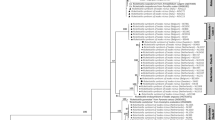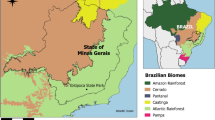Abstract
Obligate intracellular bacteria of the Rickettsiella genus are emerging as both widespread and biologically diverse in arthropods. Some Rickettsiella strains are highly virulent entomopathogenic agents, whereas others are maternally inherited endosymbionts exerting very subtle manipulations on host phenotype to promote their own spread. Recently, a variety of Rickettsiella strains have been reported from ticks, but their biology is entirely unknown. In the present study, we examined the incidence and diversity of Rickettsiella in 11 geographically distinct populations of the polar seabird tick Ixodes uriae. We found Rickettsiella in most tick populations with a prevalence ranging from 3 to 24 %. 16S ribosomal RNA (rRNA) and GroEL gene sequences revealed an unexpected diversity of Rickettsiella, with 12 genetically distinct Rickettsiella strains present in populations of I. uriae. Phylogenetic investigations further revealed that these Rickettsiella strains do not cluster within a tick-specific clade but rather exhibit distinct evolutionary origins demonstrating frequent horizontal transfers between distantly related arthropod species. Tick rearing further showed that Rickettsiella are present in eggs laid by infected females with no evidence of abortive development. Using this data set, we discuss the potential biological significance of Rickettsiella in seabird ticks. Most notably, we suggest that these organisms may not be pathogenic forms but rather use more subtle adaptive strategies to persist within tick populations.




Similar content being viewed by others
References
Goebel W, Gross R (2001) Intracellular survival strategies of mutualistic and parasitic prokaryotes. Trends Microbiol 9:267–273
Moran NA, McCutcheon JP, Nakabachi A (2008) Genomics and evolution of heritable bacterial symbionts. Annu Rev Genet 42:165–190
Duron O, Bouchon D, Boutin S, Bellamy L, Zhou L, Engelstadter J, Hurst GD (2008) The diversity of reproductive parasites among arthropods: Wolbachia do not walk alone. BMC Biol 6:27
Engelstadter J, Hurst GD (2009) The ecology and evolution of microbes that manipulate host reproduction. Annu Rev Ecol Evol Syst 40:127–149
Corsaro D, Thomas V, Goy G, Venditti D, Radek R, Greub G (2007) ‘Candidatus Rhabdochlamydia crassificans’, an intracellular bacterial pathogen of the cockroach Blatta orientalis (Insecta: Blattodea). Syst Appl Microbiol 30:221–228
Kostanjsek R, Strus J, Drobne D, Avgustin G (2004) ‘Candidatus Rhabdochlamydia porcellionis’, an intracellular bacterium from the hepatopancreas of the terrestrial isopod Porcellio scaber (Crustacea: Isopoda). Int J Syst Evol Microbiol 54:543–549
Oliver KM, Smith AH, Russell JA (2013) Defensive symbiosis in the real world—advancing ecological studies of heritable, protective bacteria in aphids and beyond. Funct Ecol 28:341–355
Cordaux R, Bouchon D, Greve P (2011) The impact of endosymbionts on the evolution of host sex-determination mechanisms. Trends Genet 27:332–341
Duron O, Hurst GD (2013) Arthropods and inherited bacteria: from counting the symbionts to understanding how symbionts count. BMC Biol 11:45
Ferrari J, Vavre F (2011) Bacterial symbionts in insects or the story of communities affecting communities. Philos Trans R Soc Lond B Biol Sci 366:1389–1400
Oliver KM, Degnan PH, Burke GR, Moran NA (2010) Facultative symbionts in aphids and the horizontal transfer of ecologically important traits. Annu Rev Entomol 55:247–266
Leclerque A, Kleespies RG (2008) 16S rRNA-, GroEL- and MucZ-based assessment of the taxonomic position of ‘Rickettsiella melolonthae’ and its implications for the organization of the genus Rickettsiella. Int J Syst Evol Microbiol 58:749–755
Leclerque A, Kleespies RG (2008) Type IV secretion system components as phylogenetic markers of entomopathogenic bacteria of the genus Rickettsiella. FEMS Microbiol Ecol 279:167–173
Cordaux R, Paces-Fessy M, Raimond M, Michel-Salzat A, Zimmer M, Bouchon D (2007) Molecular characterization and evolution of arthropod-pathogenic Rickettsiella bacteria. Appl Environ Microbiol 73:5045–5047
Kleespies RG, Federici BA, Leclerque A (2014) Ultrastructural characterization and multilocus sequence analysis (MLSA) of ‘Candidatus Rickettsiella isopodorum’, a new lineage of intracellular bacteria infecting woodlice (Crustacea: Isopoda). Syst Appl Microbiol 37:351–359
Kleespies RG, Marshall SD, Schuster C, Townsend RJ, Jackson TA, Leclerque A (2011) Genetic and electron-microscopic characterization of Rickettsiella bacteria from the manuka beetle, Pyronota setosa (Coleoptera: Scarabaeidae). J Invertebr Pathol 107:206–211
Schuster C, Kleespies RG, Ritter C, Feiertag S, Leclerque A (2013) Multilocus sequence analysis (MLSA) of ‘Rickettsiella agriotidis’, an intracellular bacterial pathogen of Agriotes wireworms. Curr Microbiol 66:1–9
Bouchon D, Cordaux R, Grève (2012) Rickettsiella, intracellular pathogens of arthropods. In Manipulative Tenants, CRC Press, 127–148
Tsuchida T, Koga R, Fujiwara A, Fukatsu T (2014) Phenotypic effect of “Candidatus Rickettsiella viridis,” a facultative symbiont of the pea aphid (Acyrthosiphon pisum), and its interaction with a coexisting symbiont. Appl Environ Microbiol 80:525–533
Tsuchida T, Koga R, Horikawa M, Tsunoda T, Maoka T, Matsumoto S, Simon JC, Fukatsu T (2010) Symbiotic bacterium modifies aphid body color. Science 330:1102–1104
Iasur-Kruh L, Weintraub PG, Mozes-Daube N, Robinson WE, Perlman SJ, Zchori-Fein E (2013) Novel Rickettsiella bacterium in the leafhopper Orosius albicinctus (Hemiptera: Cicadellidae). Appl Environ Microbiol 79:4246–4252
Gauthier JP, Outreman Y, Mieuzet L, Simon JC (2015) Bacterial communities associated with host-adapted populations of pea aphids revealed by deep sequencing of 16S ribosomal DNA. PLoS One 10, e0120664
Lukasik P, van Asch M, Guo H, Ferrari J, Charles J, Godfray H, van der Putten W (2013) Unrelated facultative endosymbionts protect aphids against a fungal pathogen. Ecol Lett 16:214–218
Leclerque A, Hartelt K, Schuster C, Jung K, Kleespies RG (2011) Multilocus sequence typing (MLST) for the infra-generic taxonomic classification of entomopathogenic Rickettsiella bacteria. FEMS Microbiol Lett 324:125–134
Duron O, Noel V, McCoy KD, Bonazzi M, Sidi-Boumedine K, Morel O, Vavre F, Zenner L, Jourdain E, Durand P, Arnathau C, Renaud F, Trape JF, Biguezoton AS, Cremaschi J, Dietrich M, Leger E, Appelgren A, Dupraz M, Gomez-Diaz E, Diatta G, Dayo GK, Adakal H, Zoungrana S, Vial L, Chevillon C (2015) The recent evolution of a maternally-inherited endosymbiont of ticks led to the emergence of the Q Fever pathogen, Coxiella burnetii. PLoS Pathog 11, e1004892
Vilcins IM, Old JM, Deane E (2009) Molecular detection of Rickettsia, Coxiella and Rickettsiella DNA in three native Australian tick species. Exp Appl Acarol 49:229–242
Anstead CA, Chilton NB (2014) Discovery of novel Rickettsiella spp. in ixodid ticks from Western Canada. Appl Environ Microbiol 80:1403–1410
Carpi G, Cagnacci F, Wittekindt NE, Zhao F, Qi J, Tomsho LP, Drautz DI, Rizzoli A, Schuster SC (2011) Metagenomic profile of the bacterial communities associated with Ixodes ricinus ticks. PLoS One 6, e25604
Kurtti TJ, Palmer AT, Oliver JH (2002) Rickettsiella-like bacteria in Ixodes woodi (Acari: Ixodidae). J Med Entomol 39:534–540
Leclerque A, Kleespies RG (2012) A Rickettsiella bacterium from the hard tick, Ixodes woodi: molecular taxonomy combining multilocus sequence typing (MLST) with significance testing. PLoS One 7, e38062
Mediannikov O, Sekeyova Z, Birg ML, Raoult D (2010) A novel obligate intracellular gamma-proteobacterium associated with ixodid ticks, Diplorickettsia massiliensis, Gen. Nov., Sp. Nov. PLoS One 5, e11478
Dietrich M, Gomez-Diaz E, McCoy KD (2011) Worldwide distribution and diversity of seabird ticks: implications for the ecology and epidemiology of tick-borne pathogens. Vector Borne Zoonotic Dis 11:453–470
Hendriks L, De Baere R, Van de Peer Y, Neefs J, Goris A, De Wachter R (1991) The evolutionary position of the rhodophyte Porphyra umbilicalis and the basidiomycete Leucosporidium scottii among other eukaryotes as deduced from complete sequences of small ribosomal subunit RNA. J Mol Evol 32:167–177
Hendriks L, Goris A, De Bruyn K, De Wachter R (1990) The nucleotide sequence of the small ribosomal subunit RNA of the yeast Torulaspora delbrueckii. Nucleic Acids Res 18:4611
Duron O, Jourdain E, McCoy KD (2014) Diversity and global distribution of the Coxiella intracellular bacterium in seabird ticks. Ticks Tick Borne Dis 5:557–563
Thompson J D, Gibson TJ, Higgins DG (2002) Multiple sequence alignment using ClustalW and ClustalX. Curr Protoc Bioinformatics Chapter 2:Unit 2–3
Kumar S, Tamura K, Nei M (2004) MEGA3: integrated software for molecular evolutionary genetics analysis and sequence alignment. Brief Bioinform 5:150–163
Castresana J (2000) Selection of conserved blocks from multiple alignments for their use in phylogenetic analysis. Mol Biol Evol 17:540–552
Crawley MJ (2007) The R Book. Wiley, Chichester
Dietrich M, Kempf F, Gomez-Dyaz E, Kitaysky AS, Hipfner JM, Boulinier T, McCoy KD (2012) Inter-oceanic variation in patterns of host-associated divergence in a seabird ectoparasite. J Biogeogr 39:545–555
McCoy KD, Chapuis E, Tirard C, Boulinier T, Michalakis Y, Le Bohec C, Le Maho Y, Gauthier-Clerc M (2005) Recurrent evolution of host-specialized races in a globally distributed parasite. Proc Biol Sci 272:2389–2395
Baldo L, Ayoub NA, Hayashi CY, Russell JA, Stahlhut JK, Werren JH (2008) Insight into the routes of Wolbachia invasion: high levels of horizontal transfer in the spider genus Agelenopsis revealed by Wolbachia strain and mitochondrial DNA diversity. Mol Ecol 17:557–569
Russell JA, Goldman-Huertas B, Moreau CS, Baldo L, Stahlhut JK, Werren JH, Pierce NE (2009) Specialization and geographic isolation among Wolbachia symbionts from ants and lycaenid butterflies. Evolution 63:624–640
Duron O, Wilkes TE, Hurst GD (2010) Interspecific transmission of a male-killing bacterium on an ecological timescale. Ecol Lett 13:1139–1148
Jousselin E, Coeur d’Acier A, Vanlerberghe-Masutti F, Duron O (2013) Evolution and diversity of Arsenophonus endosymbionts in aphids. Mol Ecol 22:260–270
Duron O, Schneppat UE, Berthomieu A, Goodman SM, Droz B, Paupy C, Obame Nkoghe J, Rahola N, Tortosa P (2014) Origin, acquisition and diversification of heritable bacterial endosymbionts in louse flies and bat flies. Mol Ecol 23:2105–2117
Mouton L, Thierry M, Henri H, Baudin R, Gnankine O, Reynaud B, Zchori-Fein E, Becker N, Fleury F, Delatte H (2012) Evidence of diversity and recombination in Arsenophonus symbionts of the Bemisia tabaci species complex. BMC Microbiol 12(Suppl 1):S10
Hedges LM, Brownlie JC, O’Neill SL, Johnson KN (2008) Wolbachia and virus protection in insects. Science 322:702
Jaenike J, Unckless R, Cockburn SN, Boelio LM, Perlman SJ (2010) Adaptation via symbiosis: recent spread of a Drosophila defensive symbiont. Science 329:212–215
Zélé F, Nicot A, Duron O, Rivero A (2012) Infection with Wolbachia protects mosquitoes against Plasmodium-induced mortality in a natural system. J Evol Biol 25:1243–1252
Moreira LA, Iturbe-Ormaetxe I, Jeffery JA, Lu G, Pyke AT, Hedges LM, Rocha BC, Hall-Mendelin S, Day A, Riegler M, Hugo LE, Johnson KN, Kay BH, McGraw EA, van den Hurk AF, Ryan PA, O’Neill SL (2009) A Wolbachia symbiont in Aedes aegypti limits infection with dengue, Chikungunya, and Plasmodium. Cell 139:1268–1278
Hoffmann AA, Montgomery BL, Popovici J, Iturbe-Ormaetxe I, Johnson PH, Muzzi F, Greenfield M, Durkan M, Leong YS, Dong Y, Cook H, Axford J, Callahan AG, Kenny N, Omodei C, McGraw EA, Ryan PA, Ritchie SA, Turelli M, O’Neill SL (2011) Successful establishment of Wolbachia in Aedes populations to suppress dengue transmission. Nature 476:454–457
Acknowledgments
We are grateful to Elena Gomez-Diaz, Thierry Boulinier, Muriel Dietrich, Aevar Peterson, Mark Hipfner, Alexander Kitaysky, Rebecca Young, Maud Poisbeau, Michel Gauthier-Clerc, Céline LeBohec, Petra Quillfeldt, Jonathan Banks, and Jacob Gonzalez-Solis for tick samples. Christine Chevillon, Elsa Léger, Valérie Noël, and Romain Pigeault are thanked for technical help. Financial support was provided by the French Polar Institute (IPEV, program nos. 333, 1151), the Centre National de la Recherche Scientifique (Programme MIE-2008), and the Agence Nationale de la Recherche (ANR-06-JCJC-0095-01; ANR-13-BSV7-0018-01).
Author information
Authors and Affiliations
Corresponding author
Rights and permissions
About this article
Cite this article
Duron, O., Cremaschi, J. & McCoy, K.D. The High Diversity and Global Distribution of the Intracellular Bacterium Rickettsiella in the Polar Seabird Tick Ixodes uriae . Microb Ecol 71, 761–770 (2016). https://doi.org/10.1007/s00248-015-0702-8
Received:
Accepted:
Published:
Issue Date:
DOI: https://doi.org/10.1007/s00248-015-0702-8




